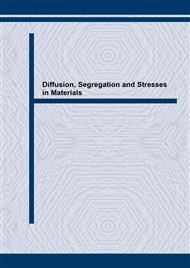[1]
M. Yamaguchi, H. Inui and K. Ito: Acta Mater. Vol. 48 (2000), p.307
Google Scholar
[2]
G. Sauthoff: Intermetallics (VCH, Weinheim 1995).
Google Scholar
[3]
H. Mehrer (Ed.): Diffusion in Solid Metals and Alloys, Landolt-Börnstein, New Series, Vol. III (1900), p.26
Google Scholar
[4]
H. Mehrer: Mater. Trans. Jap. Inst. Met. Vol. 37 (1996), p.1259
Google Scholar
[5]
P. Gas and F.M. d'Heurle: Diffusion in Silicides, in Diffusion in Semiconductors and NonMetallic Solids, Landolt-Börnstein, New Series, Vol. III (1998), p.33
Google Scholar
[6]
M. Salamon, K. Ito, M. Yamaguchi, K. Freitag, D. Eversheim and H. Mehrer: Def. Diff. Forum Vols. 194-199 (2001), p.523
DOI: 10.4028/www.scientific.net/ddf.194-199.523
Google Scholar
[7]
P.C. Tortorici and M.A. Dayananda: Met. Mat. Trans. A Vol. A30 (1999), p.545
Google Scholar
[8]
P.C. Tortorici and M.A. Dayananda: Mater. Sci. Eng. Vol. 64 (1999), p.77
Google Scholar
[9]
T.B. Massalski: Binary Alloy Phase Diagrams (Am. Soc. Metals, Metals Park 1986). [10]. K. Ito and M. Yamaguchi: private communication.
Google Scholar
[11]
S. Biersack and A. Ziegler: The Stopping and Range of Ions in Solids. in: Ion Implantation Techniques (Springer, Berlin 1982).
DOI: 10.1007/978-3-642-68779-2_5
Google Scholar
[12]
A. Gude and H. Mehrer: Phil. Mag. A Vol. A76 (1997), p.1
Google Scholar
[13]
F. Wenwer, A. Gude, G. Rummel, M. Eggersmann, T. Zumkley, N.A. Stolwijk and H. Mehrer: Metal Sci. Technol. Vol. 7 (1996), p.632
DOI: 10.1088/0957-0233/7/4/021
Google Scholar
[14]
F.M. d'Heurle and P. Gas: J. Mater. Res. Vol. 1 (1986), p.205
Google Scholar
[15]
V.I. Zmii and A.S. Seryugina: Isv. Akad. Nauk. USSR, Neorg. Mater. Vol. 7(10) (1971), p.1730
Google Scholar
[16]
A. Basu and A. Gosh: Mater. Res. Soc. Symp. Proc. Vol. 322 (1994), p.41
Google Scholar
[17]
R.W. Bartlett, P.R. Gage and P.A. Larssen: Trans. TMS-AIME Vol. 230 (1964), p.1528
Google Scholar
[18]
P.R. Gage and R.W. Bartlett: Trans. TMS-AIME Vol. 233 (1965), p.832
Google Scholar
[19]
S. Solmi, R. Angelucci, G. Cicognani and R. Canteri: Appl. Surf. Sci. Vol. 53 (1991), p.186
Google Scholar
[20]
X.Y. Zhang, W. Sprengel, K.J. Reichle, F. Baier, K. Reimann, H. Inui and H.-E. Schaefer: Phys. Rev. B (Rapid Comm.), submitted Feb. 2002. Discussion J. Philibert: I am surprised by the value of the accuracy on activation energy in you Table 2 – could you comment. M. Salamon: The listed value is the standard deviation of the linear regression, which was used to perform the fit to the measured diffusion coefficients. It is rather low due to the large investigated temperature interval of about 600 K. If we consider the experimental uncertainty of the measured diffusion coefficients also. We have to add about ±2 to the accuracy. P. Gas: You give activation energy of 1.7 eV for Ge diffusion in MoSi2. This appears to be a relatively low value (if gave refer to melting temperature). Hoveover you find on enthalpy of formation Q = 1.6 eV. What is you interpretation? M. Salamon: The ratio Q/RTm (Q is the activation enthalpy, Tm is melting temperature) for Ge diffusion in MoSi2 is between 9 and 10. This is indeed a low value. It is a consequence of the very fast Ge diffusion. If one compares the present values for the activation enthalpy of Ge diffusion with formation enthalpies for vacancies deduced from positron annihilation experiments on MoSi2 performed by Zhang et.al. and if one attributes their value to vacancies in the Si – sublattice of MoSi2 one arrives indeed at a pretty low value for vacancy migration. F. van Loo: There should be a relation between the growth constant ( ) t2 x K 2 P � = for the growth of MoSi2 between Si and Mo5Si3, the tracer diffusion coefficient D *Si and the Gibbs energy of the reaction between Si and Mo5Si3 towards MoSi2. Did you verify this relation? M. Salamon: We didn’t verify this relation up to now. This is a good idea and we will calculate the diffusion coefficient from this in order to compare them to our results. However, we expect Kp to be influenced by grain boundary diffusion due to the usual columnar growth of the MoSi2 phase in these experiments.
Google Scholar


